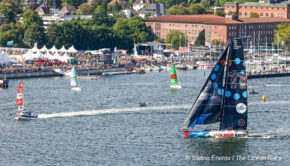Gear for Volvo Ocean Race Onboard Reporter
Published on March 2nd, 2019
By Jeremy Rellosa, Outside Magazine
Photographer Amory Ross is no stranger to the water. He’s sailed around the world in three Volvo Ocean Races as an onboard reporter, documenting the life of a crew during each 46,000-nautical-mile journey.
Ross deals with the common challenges of being a journalist: he has to meet deadlines, file photos, and edit his work. But his “office”—the perpetually damp space below the decks of a charging sailing vessel—is unique, to say the least. On a typical day, Ross has to provide a handful of images, whip up a 300-word story, and create two to four minutes of edited video for the race-media crews on land. And he’s surrounded by water for weeks on end.
So, naturally, professionals like Ross need gear that can withstand the most brutal sailing conditions. Take, for example, the rounding of Cape Horn, a leg of the race that can make even the most seasoned sailor queasy. “It’s the culmination of two to three weeks in the Southern Ocean, with 40-foot waves and 40-mile-per-hour winds,” Ross says.
“It’s as about as far from a camera-repair center as you can get.” Legs like this are, as Ross puts it plainly, “really cold,” so batteries drain faster. There’s condensation everywhere, even in the cabins. The warmth down below is enough to make everything dewy and wet. So it makes sense that one thing is top of mind for journalists like Ross: “
As a storyteller, your primary concern is keeping equipment alive.” Here’s the gear he uses to get the job done.
Cameras
When choosing equipment for an event like the Volvo Ocean Race, Ross’s first considerations are two things: size and weight. “That drives and dictates our gear-making decisions. These are light boats in the midst of a race,” he reiterates. When you need to snap a photo while getting rocked and sprayed with salt water, you want gear that won’t get in the way.
“These criteria drive you to a mirrorless world,” Ross says. Mirrorless cameras are, for the most part, slimmer and lighter than their DSLR predecessors (since there’s no mirror in front of the sensor.) “And given the variety of conditions and lighting, I was immediately pulled to the full-frame options [for a larger field of view], which pulled me into the Sony a7–series camp.
“The Sony a7R II and a7S II have incredible low-light performance for the dusk and dawn,” he explains. “The ability to switch out lenses between these cameras gives you diversity and redundancies if something breaks.”
While sailing in the 2017–18 Volvo Ocean Race, Ross began using drones, because he saw them as effective tools for onboard reporters. “Drones became an essential part of storytelling for this race. They opened up new avenues for imagery on the boat,” he says, explaining that shots had traditionally been confined to on or below deck or anywhere you could physically stand. “The Phantom 4 Pro was fantastic. With those big legs, you could really pull it out of the sky without much fuss.”

One of the biggest issues with action cams (especially ones with plastic waterproof housings) is that audio has a hard time penetrating the shell, and the result is muffled sound. “While you can get a great shot with these cameras, you don’t often get good audio to pair with it,” Ross explains.
“The Garmin Verb Ultra 30 captures audio really well.” (Credit Garmin for designing a mic port to be used with the waterproof case.) “And since audio is an essential part of the storytelling process, this cam is one of my go-to pieces of equipment.”
Lenses
“Movement is a vital consideration for an action-packed race like the Volvo, so you need a lens with a high aperture, like an f/22,” Ross says. “And the f/2.8 is important for the low-light situations. I use a 14-millimeter f/2.8 as well, which can provide super-wide shots without distortion.” Ross uses Metabones adapters to pair his Canon lenses with his Sony camera bodies.
Housings
Housings are one of the most important pieces of gear for water protection. “Aquatech housings are made of the industry-standard plastic-injected moldings—really tough, but super lightweight,” Ross says. “The surf housing lets me tweak settings [with the big buttons that pop out from the protective plastic], and dial something up or down, without the inconvenience of the bulkier dive housing.
“Toward the end of the race, I started using the Outex housing. It’s a silicone sleeve that you pull over your camera, and it allows for more versatility when shooting, while providing lots of protection,” he says. There are definite benefits to a sleeve that is malleable and contours the camera, as opposed to a clunky, hard-plastic outer, which might be stubborn if you’re trying to grip your lens or camera a certain way.
Onboard reporters like Ross rely on a handful of other accessories when it’s time to hunker down and edit the day’s images and video. Down below, in the media areas of their respective boats, onboard reporters are running the latest and greatest MacBook Pros ($1,299 and up) with Adobe Lightroom ($120). “Your hands are always wet, even when using the laptop. So I use a trackpad with a wheel to navigate, instead of a mouse, and a waterproof keyboard cover.”
And what happens when he needs to wipe away moisture? “Paper towels are your best friend. You can’t reuse rags,” he explains, “because they are most likely salty. And rubbing salt on your gear can cause scratches.” – Full Story.









 We’ll keep your information safe.
We’ll keep your information safe.